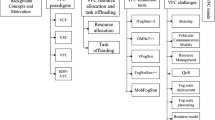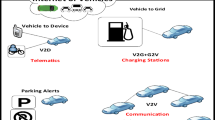Abstract
The explosive increase in the number of vehicles causes an increase in traffic congestion and environmental pollution due to CO\(_{2}\) emission from vehicles. This increases the requirements of communication and computation resources as well. The advent of fog computing has served a vital role for providing easy access to communication and computation resources by moving these resources toward the edge of the network. In the present work three different Fog computing oriented VANET based approaches in Intelligent Transportation System for reducing traffic congestion and CO\(_{2}\) emission are proposed. All the three approaches provide recommended speed to the vehicles for reducing the number of stops, rate of acceleration and deceleration which in turn helps to reduce CO\(_{2}\) emission. The performances of all the three approaches are studied qualitatively and quantitatively. The qualitative analysis is evaluated in terms of communication, storage and computation overhead whereas the quantitative analysis is evaluated in terms of both software and hardware based simulation.
















Similar content being viewed by others
Explore related subjects
Discover the latest articles, news and stories from top researchers in related subjects.Data Availability Statement
Data sharing not applicable to this article as no datasets were generated or analysed during the current study.
References
Jayapal, C., & Sujith Roy, S. (2016). Road traffic congestion management using VANET. In 2016 International conference on advances in human machine interaction (HMI) (pp. 1–7). IEEE.
De Souza, A. M., Brennand, C., Yokoyama, R. S., Donato, E. A., Madeira, E. R. M., & Villas, L. A. (2017). Traffic management systems: A classification, review, challenges, and future perspectives. International Journal of Distributed Sensor Networks, 13(4), 15501477–16683612.
Paul, A., & Mitra, S. (2018). Dynamic traffic light control mechanism in VANET. In International conference on advances in computing, communications and informatics (ICACCI) (pp. 436–440). IEEE.
Zhang, E. Z., & Zhang, X. (2019). Road traffic congestion detecting by VANETs. In 2nd International conference on electrical and electronic engineering (EEE 2019). Atlantis Press.
Paul, A., & Mitra, S. (2020). Real-time routing for ITS enabled fog oriented VANET. In India council international conference (INDICON) (pp. 1–7). IEEE.
Barth, M., & Boriboonsomsin, K. (2009). Traffic congestion and greenhouse gases. Access Magazine, 1(35), 2–9.
Paul, A., & Mitra, S. (2020). Deep reinforcement learning based traffic signal optimization for multiple intersections in ITS. In International conference on advanced networks and telecommunications systems (ANTS) (pp. 1–6). IEEE.
Khakimov, A., Muthanna, A., & Muthanna, M. S. A. (2018). Study of fog computing structure. In 2018 IEEE conference of russian young researchers in electrical and electronic engineering (EIConRus) (pp. 51–54). IEEE.
Schleicher, E., Graffi, K., & Rabay’a, A. (2019). Fog computing with p2p: Enhancing fog computing bandwidth for iot scenarios. In 2019 International conference on internet of things (iThings) and IEEE green computing and communications (GreenCom) and IEEE cyber, physical and social computing (CPSCom) and IEEE smart data (SmartData) (pp. 82–89). IEEE.
Nafi, N. S., & Khan, J. Y. (2012). A VANET based intelligent road traffic signalling system. In Australasian Telecommunication Networks and Applications Conference (ATNAC) 2012 (pp. 1–6). IEEE.
Ngo, T. T., Huynh-The, T., & Kim, D. S. (2019). A novel VANETs-based traffic light scheduling scheme for greener planet and safer road intersections. IEEE Access, 7, 22175–22185.
Suthaputchakun, C., & Sun, Z. (2015). A novel traffic light scheduling based on TLVC and vehicles priority for reducing fuel consumption and \(CO_{2}\) emission. IEEE Systems Journal, 12(2), 1230–1238.
Abdalla, L. A., Taha, R. M., Mohammed, N. S., & Osman, N. I. (2019). Reducing delay and CO\(_2\) emissions in multi-lane intersections using vehicular ad-hoc networks. In 2019 International conference on computer and information sciences (ICCIS) (pp. 1–6).
Doolan, R., & Muntean, G. M. (2016). Ecotrec: A novel VANET-based approach to reducing vehicle emissions. IEEE Transactions on Intelligent Transportation Systems, 18(3), 608–620.
Yasin, G., Abbas, S. F., & Iqbal, W. (2015). Carbon emission-aware routing protocol in vehicular ad-hoc networks. In 2015 9th International conference on application of information and communication technologies (AICT) (pp. 461–466). IEEE.
Sumon, N., & Jaekel, A. (2018). Fuel efficient route planning using VANET. In 2018 IEEE 9th annual information technology, electronics and mobile communication conference (IEMCON) (pp. 468–474). IEEE.
Xiao, Z., Xiao, Z., Wang, D., & Li, X. (2015). An intelligent traffic light control approach for reducing vehicles CO\(_2\) emissions in VANET. In 2015 12th international conference on fuzzy systems and knowledge discovery (FSKD) (pp. 2070–2075). IEEE.
Rashid, H., Ashrafi, M. J. F., Azizi, M., & Heydarinezhad, M. R. (2015). Intelligent traffic light control based on clustering using vehicular ad-hoc networks. In 2015 7th conference on information and knowledge technology (IKT) (pp. 1–6). IEEE.
Maslekar, N., Boussedjra, M., Mouzna, J., & Labiod, H. (2011). Vanet based adaptive traffic signal control. In 2011 IEEE 73rd vehicular technology conference (VTC Spring) (pp. 1–5). IEEE.
Mane, T. S., & Agrawal, H. (2017). Cloud-fog-dew architecture for refined driving assistance: The complete service computing ecosystem. In 2017 IEEE 17th international conference on ubiquitous wireless broadband (ICUWB) (pp. 1–7). IEEE.
Stanger, T., & del Re, L. (2013). A model predictive cooperative adaptive cruise control approach. In 2013 American control conference (pp. 1374–1379). IEEE.
Jabbarpour, M. R., Noor, R. M., & Khokhar, R. H. (2015). Green vehicle traffic routing system using ant-based algorithm. Journal of Network and Computer Applications, 58, 294–308.
Doolan, R., & Muntean, G. M. (2013). VANET-enabled eco-friendly road characteristics-aware routing for vehicular traffic. In 2013 IEEE 77th vehicular technology conference (VTC Spring) (pp. 1–5). IEEE.
Fontaras, G., Franco, V., Dilara, P., Martini, G., & Manfredi, U. (2014). Development and review of euro 5 passenger car emission factors based on experimental results over various driving cycles. Science of the Total Environment, 468, 1034–1042.
Hausberger, S. (2009). Emission Factors from the Model PHEM for the HBEFA Version 3.
Paul, A. & Mitra, S. (2021). Management of traffic signals using deep reinforcement learning in bidirectional recurrent neural network in ITS. In International conference on intelligent systems, metaheuristics & swarm intelligence (ISMSI). ACM.
Funding
Not Applicable.
Author information
Authors and Affiliations
Corresponding author
Ethics declarations
Conflict of interest
The authors declare that they have no conflict of interest.
Availability of data and material
Not Applicable.
Code availability
Not Applicable.
Additional information
Publisher's Note
Springer Nature remains neutral with regard to jurisdictional claims in published maps and institutional affiliations.
Rights and permissions
About this article
Cite this article
Paul, A., Haricharan, J. & Mitra, S. An Intelligent Traffic Signal Management Strategy to Reduce Vehicles CO2 Emissions in Fog Oriented VANET. Wireless Pers Commun 122, 543–576 (2022). https://doi.org/10.1007/s11277-021-08912-3
Accepted:
Published:
Issue Date:
DOI: https://doi.org/10.1007/s11277-021-08912-3




